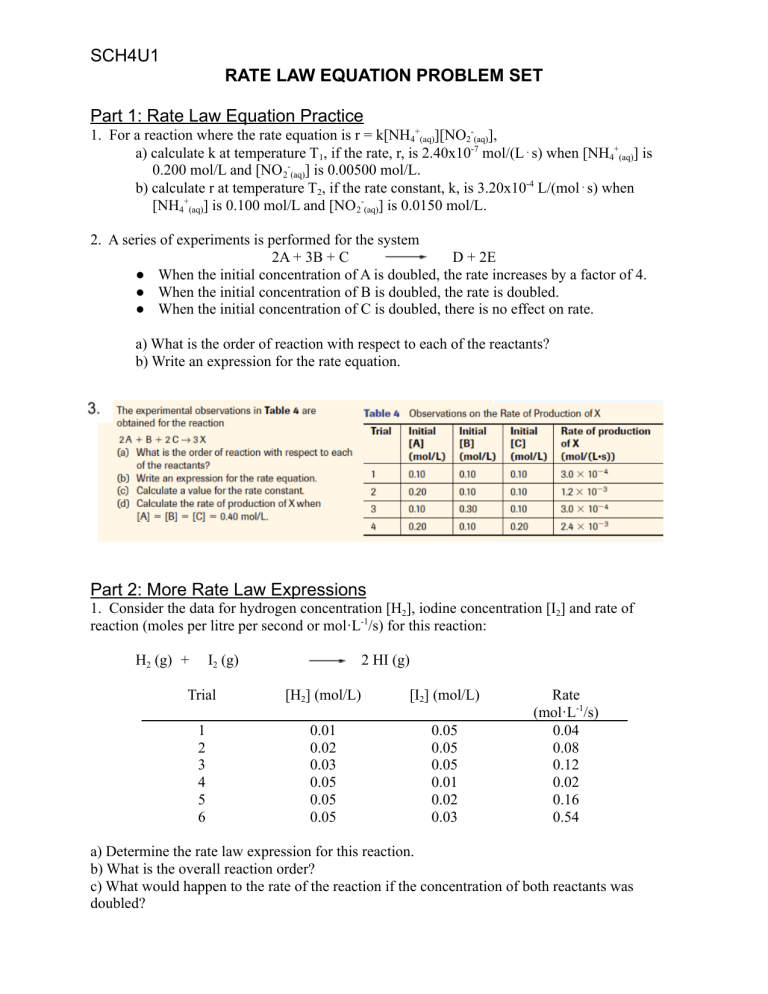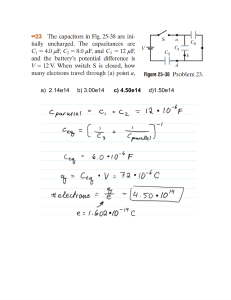
SCH4U1 RATE LAW EQUATION PROBLEM SET Part 1: Rate Law Equation Practice 1. For a reaction where the rate equation is r = k[NH4+(aq)][NO2-(aq)], a) calculate k at temperature T1, if the rate, r, is 2.40x10-7 mol/(L⋅s) when [NH4+(aq)] is 0.200 mol/L and [NO 2-(aq)] is 0.00500 mol/L. b) calculate r at temperature T2, if the rate constant, k, is 3.20x10-4 L/(mol⋅s) when [NH4+(aq)] is 0.100 mol/L and [NO 2-(aq)] is 0.0150 mol/L. 2. A series of experiments is performed for the system 2A + 3B + C D + 2E ● When the initial concentration of A is doubled, the rate increases by a factor of 4. ● When the initial concentration of B is doubled, the rate is doubled. ● When the initial concentration of C is doubled, there is no effect on rate. a) What is the order of reaction with respect to each of the reactants? b) Write an expression for the rate equation. Part 2: More Rate Law Expressions 1. Consider the data for hydrogen concentration [H2], iodine concentration [I2] and rate of reaction (moles per litre per second or mol·L-1/s) for this reaction: H2 (g) + I2 (g) 2 HI (g) Trial [H2] (mol/L) [I2] (mol/L) 1 2 3 4 5 6 0.01 0.02 0.03 0.05 0.05 0.05 0.05 0.05 0.05 0.01 0.02 0.03 Rate (mol·L-1/s) 0.04 0.08 0.12 0.02 0.16 0.54 a) Determine the rate law expression for this reaction. b) What is the overall reaction order? c) What would happen to the rate of the reaction if the concentration of both reactants was doubled? 2. Consider a hypothetical reaction: A + B C + D Doubling the concentration of A causes the reaction rate to increase by a factor of four. This is done while the concentration of B is held constant. Tripling the concentration of B, while the concentration of A is held constant, causes the reaction rate to increase by a factor of nine. a) What is the rate law expression for this reaction? b) What would happen to the reaction rate if the concentration of A was tripled and the concentration of B was doubled simultaneously? 3. Consider the reaction: NH4+ (aq) + NO2-(aq) N2 (g) + Experiment [NO2-] (mol/L) [NH4+] (mol/L) 1 2 3 4 5 6 0.0100 0.0200 0.0400 0.200 0.200 0.200 0.200 0.200 0.200 0.0202 0.0404 0.0606 2 H2O (l) Rate (mol·L-1/s x 10-7) 5.4 10.8 21.6 10.8 21.6 32.4 Determine the rate law expression for this reaction. 4. Consider a hypothetical reaction: A + B C Experiment [A] (mol/L) [B] (mol/L) 1 2 3 0.100 0.100 0.200 0.100 0.200 0.100 Rate (mol·L-1/s x 10-5) 4.0 4.0 16.0 a) Determine the rate law expression for this reaction. b) What is the order of reaction with respect to A? to B? c) What is the overall reaction order? 5. In a reaction involving only one reactant, A, the rate of the reaction increases by a factor of 27 when the concentration of A is tripled. What is the rate law expression for this reaction?




